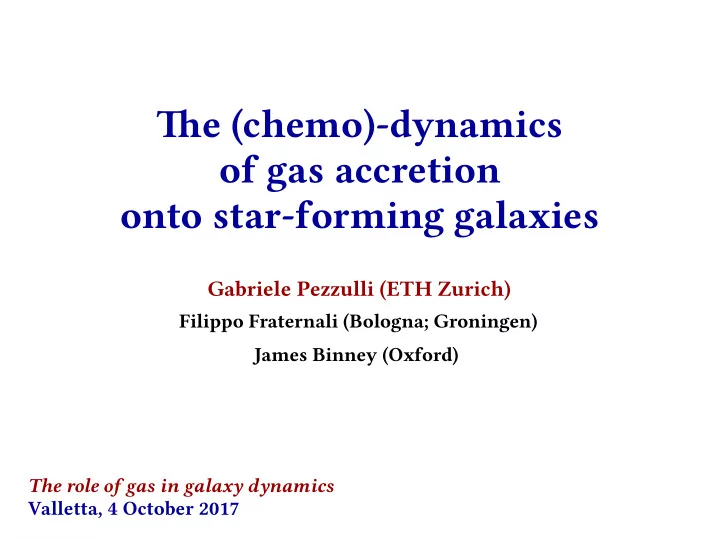

Tie (chemo)-dynamics of gas accretion onto star-forming galaxies Gabriele Pezzulli (ETH Zurich) Filippo Fraternali (Bologna; Groningen) James Binney (Oxford) The role of gas in galaxy dynamics Valletta, 4 October 2017
Accretion on star-forming galaxies Main sequence of star-forming galaxies: (cfr. Scalo 1986 birthrate parameter ) + Cold gas content approx constant since at least z~1 (DLA density distribution, e.g. Zafar et al. 2013) Continued accretion needed, also at recent times! (e.g. Fraternali & Tomassetti 2012)
Modes of gas accretion What dominant mode for star-forming galaxies at low z ? HOT MODE COLD MODE Filament CORONA DISC Filament DISC Fueling outer discs Condensation above the disc Radial fmows within the disc Directly available to star formation to fuel SF
Indications from observations ? ? CORONA Filament DISC DISC Filament Zheng + 17a M33 Ho+17 MgII “corotating” absorptions @ R ~ 0.4 Rvir Ionized infmow
Chemo-dynamical approach Data: disc structure, metallicity gradients, kinematics. “easy” (easier) Modeling: Chemo-dynamics : much more diffjcult? α-elements (Fe Time-delay efgects) Schönrich & Binney (2009) Multiple populations, ISM (Stars migration.) Star formation (source) Accretion Normalized (dilution) abundance Linear equation Closed-form solution GP & Fraternali (2016)
Purely vertical accretion Abundance gradient DISC TIME “Independent annuli” Spatially resolved → surface densities
Purely vertical accretion Abundance gradient DISC MW obs gradient Genovali et al. (2015) “Independent annuli” Spatially resolved → surface densities Ways out, tuning: - accretion time-scales - star formation effjciencies - .
Purely radial accretion RADIAL MASS FLUX Filament Filament Incoming DISC fmow Gradual consumption (star formation) RADIAL VELOCITY
Purely radial accretion Filament Abundance gradient Filament DISC RADIAL VELOCITY Along gas trajectories (Method of characteristics) Edmunds & Greenhow (1995) GP & Fraternali (2016)
Is the truth in the middle?
Dynamics of gas accretion - Purely radial accretion - Filament F i l a m e n t DISC Who to transfer the angular momentum to? To the stars? (spiral structure; bar interactions) To the gas itself? (viscosity? violent disc instability?) To the dark matter?
Dynamics of gas accretion - Purely vertical accretion - INNER CORONA Pressure negligible Cold disc DISC Hot corona rotation + pressure ONLY IF
Dynamics of gas accretion Vertical accretion + radial fmows! INNER CORONA Pressure negligible Cold disc DISC Hot corona rotation + pressure e.g. Pitts & Tayler (1989) Radial fmows Bilitewski & Schönrich (2012) Dynamically coupled fmows! GP & One parameter: AM mismatch (due to ) Fraternali (2016) Solved with “method of characteristics”
Hot-mode accretion with radial fmows GP & Fraternali (2016) Bilitewski & Schönrich (2012) Model requirement First direct observation (Hodges-Kluck, Miller & Bregman 2016)
A hydrodynamical GP, Fraternali & cosmological model Binney (2017) Rotating equilibrium Angular momentum From Cosmology distribution (AMD) (tidal torques) Required velocity matched with minimal assumptions and cosmological AMD
Summary Chemo-dynamics is. - “not so diffjcult” - sensitive to the mode of accretion Star formation (at low z) can be fueled like this: INNER CORONA DISC Natural consequence of hot-mode accretion with a cosmological AMD
Recommend
More recommend